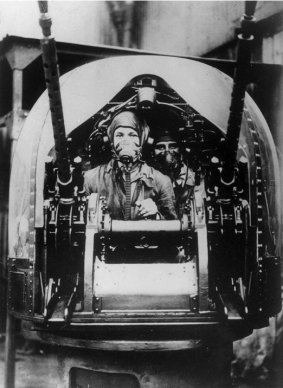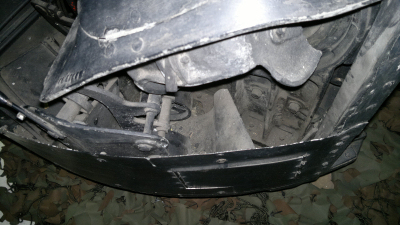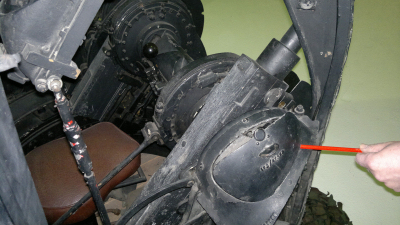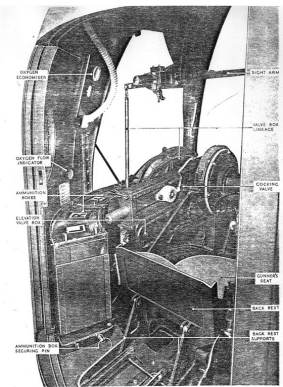The Rose Turret
The Rose turret has intrigued many people for decades, me included, and so when I needed to find out a bit more about it for the writing of "Falcon" I decided to take a good look. What follows is a mainly technical account of the turret and what it meant to the gunner.
The Rose TurretThe Rose Turret, which was in service with 1 Group Bomber Command from the middle of 1944, was a replacement for the Frazer Nash rear turret fitted to Lancaster bombers. Instead of four .303in Browning machine guns, it used a pair of .50in Browning Mk2 machine guns and this was intended to provide more firepower for the defence of those bombers. The .50in turret was not designed and built by any of the existing turret manufacturers, but was designed and built by Rose Brothers, a small engineering company in Lincolnshire. This is a classic view of the Rose turret as installed in a Lancaster. The advice to rear gunners was that it was possible to bale out of the turret by simply diving out head-first over the guns. It has to be said that any gunner wearing a thick, heated Taylorsuit would probably find it more of a wriggle than a Tom Daly... |
 |
The main differences between the Rose turret and the Frazer Nash rear turret were as follows:
One: the ammunition for the Frazer Nash turret was stored in tanks in the rear fuselage, and the belted .303 rounds were fed along metal chutes to the underside of the turret from where they were led up to the gun breeches. The Frazer Nash turret had 1,900 rounds per gun in the ammo tanks and 600 in the chutes, giving a total of 2,500 rounds per gun for each operation. This would provide around 130 seconds firing time. The Rose turret was not fed ammunition from tanks installed in the rear of the fuselage, but carried its ammunition in four boxes, two per gun, installed in the turret itself. Each box contained 150 rounds which, along with the top layer of rounds that ran in to the guns themselves, would provide about 350 rounds per gun. This would provide about 27 seconds firing time.
An additional box of ammo would be carried for each gun in the rear fuselage and could replace a used box, the new belts being linked to the existing ones by means of a make-and-break tool carried inside the turret. The reason why the ammo was contained in the turret and not in rear-fuselage tanks was that the Rose turret could then be a drop-in replacement for the Frazer Nash, fitted in hours, rather than the days needed to install a remote feed arrangement.
| Lancaster rear turret | |
 |
Two: The control of the Frazer Nash turret (see left) was by means of a "bicycle handlebars" control column which allowed the guns to be elevated and traversed hydraulically. Aiming was by means of a MkIII gunsight installed at eye-level. Note the MkIII gunsight at the top of the picture, and the uninterrupted view through the rear panel between the sight and the handlebars. Control of the Rose turret was effected by grasping the MkIIIa gunsight box and moving it in the direction of the target. This activated the hydraulic actuators and performed elevation and traverse as required. The designers believed that this was a more instinctive (today we would say "ergonomic") means of lining up on the target. |
The Rose turret, after a shakey start with the quality control of the main turret traverse bearing, was generally well-regarded. There was empirical evidence that, once the Luftwaffe discovered that the Rose turret had a bigger sting than the Frazer Nash, German fighters were more reluctant to press home an attack, although when the guns were brought into use, they tended to jam more frequently.
The images used in this article are sourced from Rose Brothers documentation and my own archive. My thanks to Peter Elliott, Head of Archives at the RAF museum, Hendon, for allowing me to examine the Rose turret in detail and for holding the pencil.
The second man mythThis is another classic shot of the turret, taken in the factory. This image has led many people to believe that the Rose turret was large enough to accomodate two people, and the publicity department of Rose Brothers did not help matters by stating this was the case, almost certainly based purely on the image itself and not by referring to their engineers. The description went on to suggest that the second man could be setting the gunsight computer. This is all a complete myth. First, the Rose turret used the standard RAF MkIIIa non-computing reflector sight and second there is simply no room for a second airman in the turret. Two skinny schoolboys might fit inside, but two gunners in Taylorsuits? No chance... The second man is looking over the gunner's shoulder from outside the turret, through the open rear doors, the gunner having slid slightly to one side to allow the camera to catch the second man. There is a rationale for having a second man outside the turret; a loader, ready to swap in the spare box of ammo, which weighed 50 pounds and which the gunner could not change for himself without climbing out of the turret. Note that the gunner's hand is resting on the lower 'search' joystick that peritted the turret to traverse. |
 |
Note also the "sight box", which comprises a large handle with the MkIIIa sighting head on top, at the top of the photo, just underneath the Perspex screen. Because the guns and the sight box move together, and the guns are elevated in this shot, the sight box is also elevated. This is the control mechanism that the gunner has to grasp while engaged in tracking and shooting at a target. This could be tiring for a gunner if engaged in a long period of defence against any fighter(s).
Note also the way in which the back of the seat can be lowered to a horizontal position to allow the gunner to get into the turret more easily.
There are some very nice photographs of the exterior of the RAF Museum Rose turret on the net, so I do not intend to duplicate such images here. The emphasis will be on the working parts of the turret.
Interior left side
At the top right of the photo is the MkIIIa gunsight which is fixed to the sight arm. The gunner would grasp the sight box and move the sight so as to line up on the attacking fighter. Moving the sight also moved the control rods, or "valve box linkage", and hence the guns. One such linkage can be seen in the lower left of the photo.
To the left of the control rod, the feed rollers can be seen. If an ammunition box had been in place, these would not be visible. At the lower right-hand side of the photo, the "search joystick" can be seen. This allowed left / right traverse, with less arm-ache, so the gunner could scan the port and starboard rear quarters for threatening fighters. Below this can be seen the hand-crank for manual rotation of the turret. And below this is the gunner's seat, which is not square, as with the Frazer Nash seat, but is contoured so it tends towards a 'saddle' style. Presumably this was felt to be a more comfortable shape for a gunner, whose backside might have to endure an operation of up to eight hours duration. |
 |
 |
Right hand feed channelThis image shows the right-hand down feed channel that takes the ammo belt down from the front box. The belt feeds down to the bottom of the chute and is then taken up again by a guide roller. |
Riser feed channelThe ammo belt is then taken into the riser guide, which twists the belt 90 degrees clockwise so that it is correctly presented to the gun breech. The final line-up with the breech is made by a sprocket-roller that engages mechanically with the ammunition belt. |
 |
 |
The loading coverThere is a curved panel that protects the belt as it passes over the sprocket roller next to the breech, and to provide access to the belt a small hatch opens to allow the armourer / gunner to pull the belt upwards towards the breech; a rod with a hook on the end was undoubtedly used for this. Once the belt had been pulled into the open breech of the gun, the breech cover would be locked down and the gun cocked, most probably by use of the cocking valve once safely airborne. |
Analysis of the effectiveness of the Rose turret
To be able to write the above description of the Rose turret, and to formulate the following analysis, I researched fairly widely. Nevertheless, I am bound to have missed some important sources. Research is rarely complete; if it was, we would never have to write any more history books. So, I would be very happy to hear from the air armament cogniscenti on any aspect of this study and would be happy to blog the points raised.
"Bomber" Harris had, by the end of 1942, concluded that for a turret to be effective it would have to have the following features:
An uninterrupted field of view
Guns of a calibre that would defeat enemy armour
Easy escape for the gunner
Effective turret heating
Harris tried to get the Air Ministry to commission such a turret but they seemed incapable of addressing the issue. Famously, Harris eventually went straight to the Rose Brothers for an answer.
Thus the Rose turret was born out of the need to provide the rear gunner of the Lancaster bomber with a gun that would have a greater range and penetration than the .303 that had been the standard for air armament since the start of WWI. As mentioned above, Rose Brothers were given the job of designing and building the turret by "Bomber" Harris himself, and they were chosen as they had for several years provided the RAF with quality engineering solutions to a number of problems, including gun mountings for the Hampden bomber and, according to legend, components for the "Dam Busters" Lancasters.
Rose Brothers had actually already made excursions into power-assisted gun mountings, as evidenced by earlier patents. These patents describe mountings for single and double heavy machine guns which feature conventional control handles, with electrical firing triggers, positioned close to the gun breeches. The gunner would move the control handles so as to aim at the target and the guns would then be moved hydraulically with his intended aim. This was power-assisted movement of "free-mounted" guns rather than servo-control of a powered gun turret.
The Rose Brothers were given assistance in the design of the turret, this being facilitated by Air Vice Marshal Edward Rice, a close associate of Harris. Thus the main features of the turret conform to several of Harris's dicta: a good field of view, .50in Browning machine guns, and an easy escape for the gunner. (In fact, Harris wrote to Rose after VE Day commenting that there were several Rose gunners who had been the sole crew members to escape from doomed Lancasters.) Turret heating did eventually get installed in a number of Lancaster turrets from late 1944, but not the Rose Turret. Harris also noted that the controls were of a different design to the FN turrets, but made no further comment on this. However, the controls were a very distinct product of the Rose philosophy of powered control.
The philosophy of providing power-assisted control of the guns, based on the "natural" aiming movements of the gunner, persisted in the design of the Rose turret. Where a servo-control joystick would have been quite adequate (as with the FN turret) the Rose designers appear to have been wedded to the "power assist" concept rather than the separate "joystick" or "control handle" concept used by FN. Thus, to the Rose design team, the gunner should make to move some part of the sight / gun mounting structure to invoke the powered movement rather than operate a physically separate control such as a joystick. If Rose were receiving advice on their turret design from the RAF, it is certain that the RAF would never have suggested this approach. It is likely that Rose told the RAF that their method of power assist was already well-developed and should be used to save design time. Whether Rose also, at that time, told the RAF that this method of control conformed to the company's own ideas on searching for a target and engaging it might well be doubted as it ran counter to well-established air fighting principles.
The Rose Brothers documented their aiming concept, and in summary it is this:
The "old" method of preparing to meet an attack is for the gunner to scan the sky for the enemy, and when he sees an attacker he moves his turret controls, which brings the gunsight and the guns to bear on the attacking aircraft. According to the Rose Brothers, this loses valuable time. The "new", or Rose, method was to scan the sky for an attacker through the gunsight, and when an attacking aircraft was viewed through the sight the guns would have automatically been brought to bear on it and could be fired instantly, thus saving valuable time. On hearing this, any experienced air gunner would, at the very least, have made a sharp intake of breath.
In air-fighting, whether performed by a fighter pilot or an air gunner, the widest possible view of the sky is the over-riding need. The gunner divided the sky into a series of overlapping segments and scanned each in turn, briefly fixing his gaze on each to register any airborne objects, and fixing his gaze helped register any object in his visual range, especially if it was moving. And the gunner often traversed the turret while searching, both to make the visual search more effective and to keep the hydraulic motor fluid 'lively'. Doing this allowed him to pick up a potential attacker at the earliest possible opportunity and to bring the guns to bear, and his wide field of vision would have allowed him to take up any necessary deflection.
However, a gunner confining his view to the few degrees offered by the reflector gunsight, especially the small MkIIIa, would only be able to scan the sky at an incredibly slow rate, during which time he could miss an attacker approaching from outside his limited field of view. Should he by any chance have picked up an attacker in his sight by this method, he would then have had to add in any required deflection and, critically, both the fighter and the deflection aiming point may not actually have been contained within the small optic of the MkIIIa. Also, holding the hands up to continually grasp the gunsight box of the Rose turret was tiring and simply impractical for the duration of a long bombing operation.
It was probably these considerations, most likely suggested by the RAF advisors, that prompted the Rose team to add the "search" joystick for easy traverse of the turret. Whether a debate ever took place on the Rose method of control and aiming via the sight box on the sight arm is probably now lost to history, but insisting on a change to a joystick would probably have been impossible given the time constraints. Thus the Rose turret retained its "power assist" concept.
Actually, if the sight had been fixed at eye-level and had moved the guns by limited tilting and turning, in the same way as later barbettes were operated by a remotely-positioned gunner, then the Rose turret would indeed have been very ergonomic. However, the sight/control grip remained fixed to the sight arm, which required large movements to match the required movement of the guns, and this should be considered a major conceptual flaw. But Rose was proud of the concept; as late as 1954, when gunners were sitting in pressurised crew positions and operating barbettes by remote control, Rose renewed his patents for the open rear turret.
However, the Rose turret answered the requirement as stated: it resulted in a turret with powerful guns that could replace a Frazer Nash turret in hours. But how did it stand up against the turret it was replacing?
Although the .50in guns outperformed the .303in guns in their effect on an enemy fighter, the limited ammunition supply was a serious consideration. The FN turret had enough ammunition for 130 seconds firing, but the Rose turret only 25 seconds. Also, the guns of the Rose turret did not have power-assisted feed for the ammo belts and this led to the number of stoppages being three times greater than for the FN turret. There is evidence that once the German fighter pilots realised that the Rose turret had a nastier bite than the FN, they held back. However, that would only be the case on a daylight operation; at night the usual German tactic of creeping up under the bomber and shooting upwards would continue. And the amount of ammo for scare bursts and firing for effect would not last long should the gunner encounter a pair of experienced fighter pilots who might split his fire and jink ever-closer to his aircraft for a final close-in attack; and swapping in the fresh box of ammunition would have been impossible if an attack was in progress.Thus the Rose turret was probably at its best on short-range daylight operations rather than deep-penetration night operations. The field of fire was very good, and the superb view, and thus early spotting of an enemy, is credited with having saved a number of Lancasters. The Rose turret was credited with being popular with the gunners - its punch, good view, and easy escape probably being the reasons, but the limited ammunition would have been a real concern for the gunner. Experienced gunners in the USAAF would take vast amounts of spare ammunition on operations (albeit against orders) but the Rose turret gunner had just one spare box per gun which a fellow crewmember would have to change for him. And it is somehow doubtful that grasping the sight box was ever preferred to the FN "bicycle handles"; one moment the gunner is using the traverse joystick, a fighter is spotted so his hands go to the sight box, and a good part of his sky view is then blocked by his forearms.
But there was another factor; after "Big Week" in February 1944, when the USAAF carried out a sustained and devastating attack on the Luftwaffe, fewer fighters were encountered. The Rose turret came into service just as the aerial opposition was evaporating, and the anticipated slugging match never materialised.
Conclusion
The Rose turret came in for a deal of praise from senior officers within Bomber Command because, despite the problems, it had some tangible benefits (as already stated) to offer once daylight operations began to dominate, and experienced rear gunners would have simply ignored the "Rose method" of scanning for targets and done what they always did, but the use of the sight box as the controller was less ergonomic than the FN "handlebars".
And it was not the fault of the Rose Brothers that they had to limit the amount of ammunition to that which could be carried in the turret. However, it can be said that had the Rose turret had its ammo tanks in the rear fuselage, with significantly more ammo, and had been provided with a servo feed like the FN turret, then the stoppage rate would probably have been as low as for the feeds in USAAF turrets. And had the sighting and control method been the same as with the FN, then the Rose turret would have been an undisputed winner.
© Copyright 2007 CairdPublications.com | Site Map | Contact Us |


